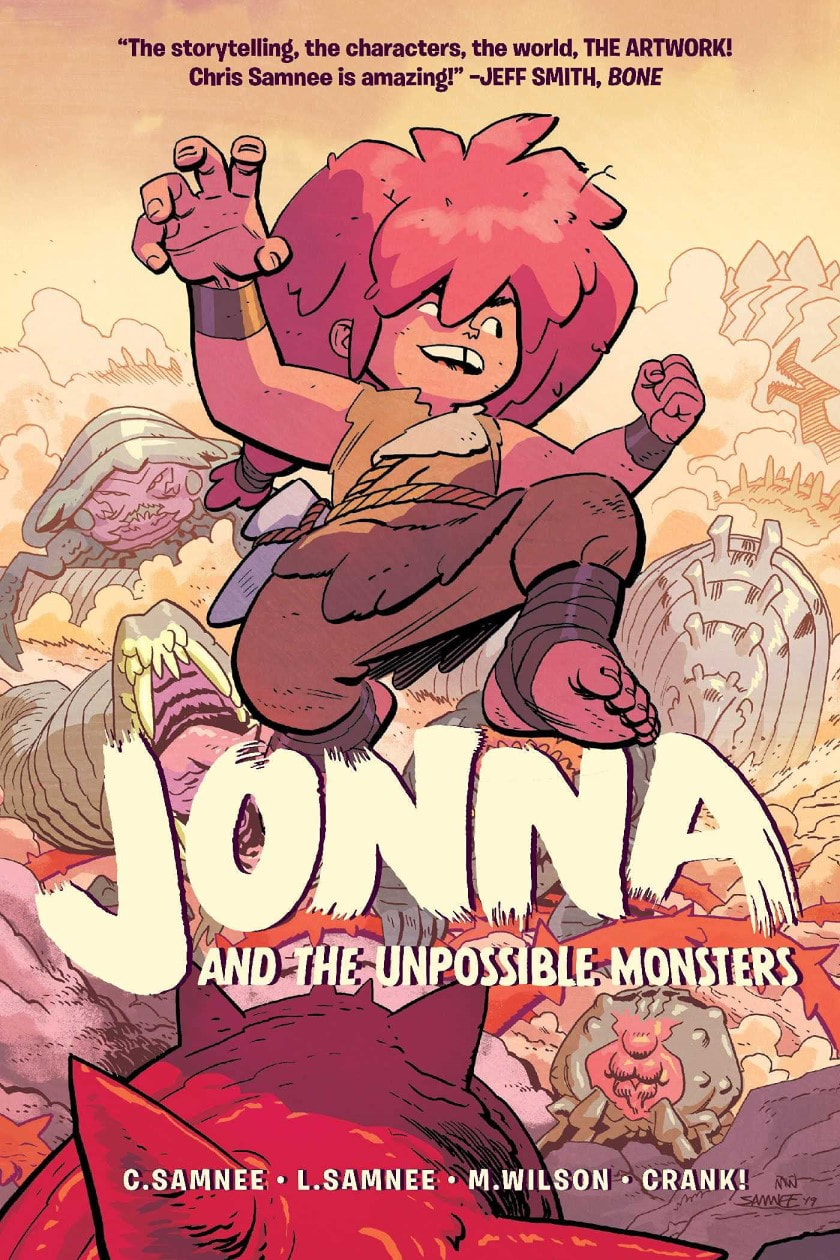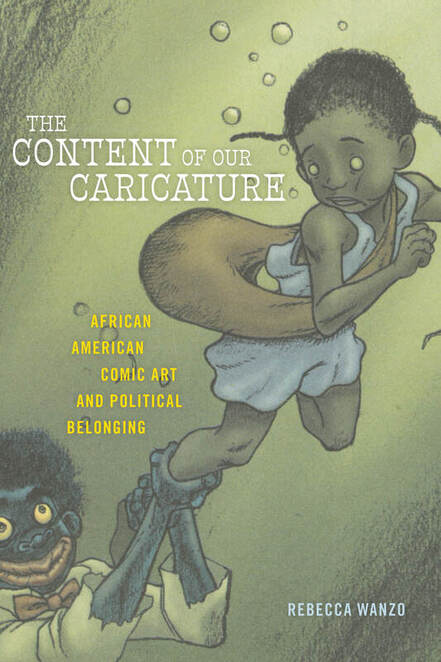|
Snapdragon. By Kat Leyh. First Second, 2020. ISBN 978-1250171115, $US12.99. 240 pages. I favored Snapdragon to win this year’s Eisner Award for Best Publication for Kids (though, um, another book ended up winning). Of all the recent comics about witches that I’ve reviewed here, Snapdragon strikes me as the most sure-handed and persuasive, as well as the richest. It shares with most of the other “witch” books a progressive, inclusive, queer-positive ethos and Bildungsroman structure. Snapdragon, though, brings even more to the table, without ever overcramming or pushing too hard. Unsurprisingly, the book has a utopian, welcoming, vibe, but author Kat Leyh stirs in so much complicated humanness that the results never seem pollyannish or schematic. What we get is a winningly complex cast of characters, queer and trans representation that is central to the story while being gloriously unflustered and direct, spooky supernatural details that resolve into unexpected affirmations, and, above all, vivid and confident cartooning – one terrific, nuanced page after another. I was just a few pages in when I realized that I was in the hands of a master comics artist. The book has guts. Its first panel delivers a closeup of hungry birds tearing into carrion (roadkill), then zooms out to Snapdragon, or Snap, barreling through the woods on her bike. “Our town has a witch,” Snap’s opening captions tell us. “She fed her eye to the devil. She eats roadkill. And casts spells with the bones…” So, by way of opening, Leyh leans into the creep factor: But Snap, a fierce young girl, isn’t having it; the town’s rumors of a witch are “bull,” she thinks. “Witches ain’t real,” her skeptical thoughts go, as she brings her bike skidding to a halt in front of the witch’s (?) home. But soon enough Snap has joined forces with this supposed witch, a quirky old woman named Jacks who cares for animals but also salvages and sells the bones of roadkill to collectors and museums. Is Jacks a witch? Does she wield real magic? The book remains coy about this until halfway through, but Snap quickly bonds with Jacks, who welcomes Snap into her work, mentors her in animal anatomy and care, and becomes a sort of avuncular (materteral?) queer role model. That bond helps Snap claim her own implied queerness – that, and Snap’s friendship with Lou/Lulu, an implicitly trans schoolmate labeled as a boy but anxious to claim her girlness. All the book’s relationships are worked out with care, including the crucial one between Snap and her overworked but wise single mom, Vi. Leyh’s characterization is slyly intersectional, including sensitivity to class (Lu and Snap are neighbors in a mobile home park, a detail conveyed with knowing matter-of-factness). Almost every character has more to give than at first appears – the sole exception being Vi’s toxic ex-boyfriend, a heavy whose sudden reappearance at the climax is the book’s one surrender to convenience. Everything else feels truly earned. Snapdragon is the kind of book that, described in the abstract, might seem to be playing with loaded dice. In less sure hands, its story could have come across as pat and programmatic, a matter of good intentions as opposed to gutsy storytelling. But, oh, Leyh is absolutely on point here; her mix of irrepressible cartooning and narrative subtlety, of bounce and insinuation, is a wonder to behold. Snap and Jacks are great characters, and in good company. Their world feels real and vital. Leyh infuses their story with grace, understanding, and nonstop energy. I’ve read this book multiple times and expect to read it again. I’d read sequels, if Leyh wanted to offer any. And I’ll follow her whatever she does.
0 Comments
Jonna and the Unpossible Monsters. Book One. Written by Chris Samnee and Laura Samnee. Drawn by Chris Samnee. Colors by Matthew Wilson. Lettering by Crank! (Christopher Crank). Oni Press, August 2021. ISBN 978-1620107843, $US12.99. 112 pages. Jonna and the Unpossible Monsters has a premise that was just waiting to happen, one that somebody, somehow, had to get around to: a postapocalyptic children's fantasy about fighting giant, kaiju-like monsters. There's a touch of Jack Kirby's Kamandi, the Last Boy on Earth about this, and maybe a touch of Pacific Rim too. Co-creators Laura Samnee and Chris Samnee describe Jonna as a story they "could share with [their] three daughters," something created "for them" but also "inspired by them"; the comic, though, will appeal to action-starved fans of Chris Samnee's work on such superhero comics as Thor the Mighty Avenger, Daredevil, Black Widow and Captain America (or his current martial arts fantasy with writer Robert Kirkman, Fire Power). The heroic Jonna is a wild, monster-clobbering girl with a whiff of Ben Grimm or Hellboy. She comes across as untrammeled, almost feral, yet delightful. When Jonna goes missing in a ruined, kaiju-ravaged world, her older sister Rainbow – the more fretful, responsible one, naturally – tries to find her, then corral and (re)civilize her. Jonna, though, remains a unpredictable force of nature. You don't need to know much more; the first half dozen pages give you whopping big monsters, and plenty of synthetic worldbuilding. There's a sense of the familiar about all of it, but novelty and excitement too. By now it's almost a cliché to speak of Chris Samnee's masterful storytelling and sheer chops (I've paid tribute before). It is true that I will read just about anything drawn by him, especially when it's colored by Matt Wilson, his steady collaborator for more than a decade. Granted, I got impatient with Fire Power within a few issues. Though I dug its bang-up start, Fire Power strikes me as a shopworn White martial arts fantasy à la Iron Fist; it's tropey, and conceptually a bit tired. I've stayed with it, however, because of Samnee and Wilson's visuals, and it has become my monthly dose of old-school craft and loveliness, balancing breathless action with an Alex Toth-like elegance. Samnee manages to be polished and rugged at once; his drawing offers classicism and grace, but with a terrific infusion of energy. Jonna, I think, may be the best thing he has ever done: the pages sing, and roar, and astonish with their gusty action and playfulness. Freed somewhat from the stylized naturalism of mainstream superhero comics (though that skill set is still very much in evidence), Jonna cartoons with a joyful freedom. Wilson's coloring, too, is eye-wateringly good. All this is my way of saying that Jonna is craftalicious and affords plenty of gazing and rereading pleasure after the initial readerly sprint. But what does it amount to? On some level, it remains a kind of superhero comic, not only because Jonna packs a mean punch but also because a couple of other characters discovered along the way, Nomi and Gor, are seasoned fighters as well (Nomi boasts powerful prosthetic arms). So, this is a slugfest. But there's more: moments of poignancy, sisterly anxiety, and Jonna's weird, ferine energy and charming social cluelessness. And the Samnees allow a certain melancholy to creep in; the world of Jonna is a fallen one, full of sundered families, lost loved ones, bereavements. In one scene, a ragtag group of survivors huddles around a fire, and their dialogue says a lot: My whole family gone. My home destroyed. My village destroyed. Everything destroyed. Without pressing the point, the story has a genuinely apocalyptic feel that, to me, reeks of COVID. That it manages to be cockeyed and funny at the same time is no small feat. Though billed as a children's story, Jonna is just as much for grownups. The book (originally serialized in floppy form) splits the difference between direct market-oriented cliffhanger series and middle-grade graphic novel, so it's courting multiple audiences. Moreover, a theme of "families and belonging" (as the Samnees put it) threads through the book, familiar from many an animated family film, and like such films Jonna offers adults a kind of reassurance even as it aims for kids. That is, it offers childhood as a cure for ruin and heartbreak. The basic ingredients are familiar – there's nothing revolutionary about this tale – but I'm at a time in my life where seeing kids wallop monster does me a world of good. This first volume (a second is promised for Spring 2022) sets up some mysteries, not least the mystery of Jonna herself, and doesn't answer very many questions, but I enjoy paging through it and rereading it. In fact, I enjoy it more than I can say. PS. The excellent magazine PanelxPanel, by Hass Otsmane-Elhaou and company, devoted a good chunk of its May 2021 issue (No. 46) to Jonna, and includes a revealing interview with Chris Samnee. Plus, the issue contains other articles on depictions of children and on young readers' graphic novels. Well worth checking out!
The 2021 Eisner Awards were announced in a virtual ceremony or video released on Friday, July 23, part of Comic-Con@Home. The ceremony, hosted (once again) by actor Phil LaMarr, runs just over an hour and can be viewed via YouTube on the Comic-Con International channel: https://youtu.be/RuVslpoC2nI This year's was a solid and fairly satisfying Eisner Awards crop, and mostly unsurprising, given the ballot announced on June 9. Out of the thirty-two award categories, I was mildly surprised by five or six. Going into the ceremony, I had strong feelings about just three or four categories. In almost all cases, my daughter Nami was able to call the winner just before LaMarr announced it! These past few weeks, I’ve been checking out a number of Eisner nominees and winners from my local library, the LAPL. Good reading! I congratulate all of this year's winners, and, again, particularly congratulate the nominees in the Academic/Scholarly Work category. Readers, do seek out all the books in that category, especially the Award-winner, Rebecca Wanzo's The Content of Our Caricature, which is innovative and important! As I've said before, when that book came to my mailbox, I stood transfixed and read a whole chapter before even sitting down. The book is brave, startling, and bracing: a must. My congratulations to Dr. Wanzo on this well deserved (further) recognition! PS. I hope I will be able to write up some of my recent reading here at KinderComics. This is a time of bereavement and struggle for my family, so my writing and reading time is sorely limited, but I do hope to reconnect, here, in this space I've tended for so long. Peace, everybody.
|
Archives
June 2024
|









 RSS Feed
RSS Feed
